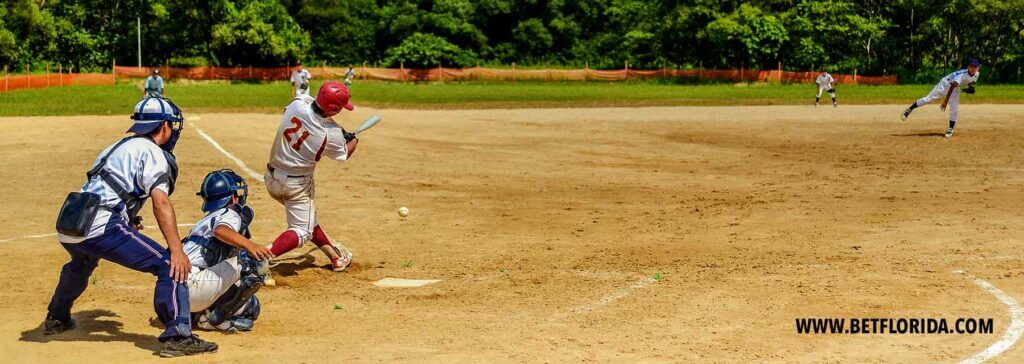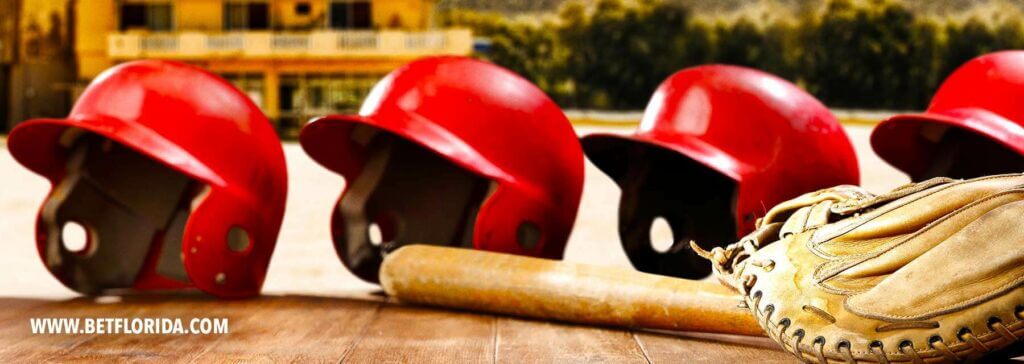Basic MLB Rules
The MLB rule book states that the rules govern the playing of baseball games by professional teams of Major League Baseball. It also includes any leagues that are members of the National Association of Professional Baseball Leagues.
To know the MLB rules when betting on MLB is vital for your success. If you don’t know most aspects of the rules in the game, you might not know the conditions for a bet to be successful.
We will guide you through all that we think you need to know to be a successful bettor in the Baseball world.
Game Objective in Baseball
The game is played with two teams, each of which has nine players. The teams play under the direction of their managers on an enclosed field.

The objective of each team is to win by scoring more runs than the other team. The winner of the game is the team with the most runs. Many fans loves to bet on most runs in baseball game as long as they get good odds from the bookmaker.
Baseball Field
The game takes place on a field that is also known as the ‘diamond‘ due to the shape of the infield. The infield is the area from the grass line to the home plate and must be a 90-foot square. It must be graded so that the home plate and baseline are level.
The pitcher’s mound is the raised area of dirt in the middle of the infield. On the top is a rubber or plate where the pitcher must keep his foot when pitching. There are four bases, namely first, second, third base, and home plate.
The bases form a diamond shape and start with the home plate. The rectangle on each side of the plate is the batter’s box, from where the batter hits the pitches. Behind the batter’s box is the catcher box, where missed pitches are caught by the catcher.
The outfield is between the grass line and the home run fence. It’s a large area covered by three players. In the major leagues, the fence must be 250 feet or more from the home plate.
Player Roles
When a team plays offense, all the players (except the pitcher) become hitters when it’s their turn to bat. The team playing the defensive side does so in nine positions.
These include the catcher, pitcher, first, second and third base, right and left field, and center field. The defensive positions can be divided into three main categories:
- Infielders
- Outfielders
- The Battery
Four players make up the infield, three covering the bases and one shortstop. Their main objective is to field the ball while it’s in play. The outfield has three positions:
- Right field
- Left field
- Center field
These three are responsible for catching the fly balls and running down baseballs that make it past the infield.
The catcher and the pitcher are the two players that make up the battery. The pitcher throws the ball towards the batter over or near the home plate to the catcher. The batter tries to hit the ball, and the catcher catches any balls the batter misses.
Scoring in MLB
When a ball is hit by the batter, he runs to first base. It’s the next hitter’s job to ‘drive him in’ by hitting the ball so he can proceed to second base. A runner needs to cross the home plate safely to score for their team.
He gets to home plate by being driven in by hits from fellow hitters. Other ways to get to home plate are through a fielder’s choice, an error, or a walk with the bases loaded.
If a batter hits a home run, he can score a run by himself. A home run is usually when the ball gets hit over the outfield fence.
When this happens, the batter and everyone on the bases scores. The team with the most runs over during the nine innings of the game wins.
Player and Team Rules
Players and teams must adhere to some basic rules to keep the gameplay fair. The teams must stick to the batting order that has been chosen by the manager. At all times, they need to wear the required apparel, especially helmets and gloves.
Pitchers should be aware of the strike zone and not try to hit the batter to inflict injury. The players need to adhere to the umpire’s rules and decisions made during gameplay.

Overall, good sportsmanship should be practiced throughout the game and respect shown to all players and officials.
Coach Rules
In baseball, the head coach is commonly referred to as the field manager. He is responsible for overseeing and making final decisions regarding the team.
Decisions such as on-field team strategy, lineup selection, and training agendas are made by the manager.
The team is also allowed to place two base coaches on the field when it’s time to bat. One is stationed near first base and the other near third base. They assist in guiding the players regarding base movement during play.
Time Limits and Game Duration
At the level of the Major Leagues, there is no time limit for games. Games last nine innings and are over when those innings are completed. It doesn’t matter if this takes three or ten hours.
An umpire may call ‘time’ on the game and end it if he feels that the game shouldn’t continue due to dangerous weather or poor lighting, whereby the umpires can’t follow the game.
Overtime Rules
The game could go into extra innings if there is a tie on the scoreboard. If the visiting team gains a lead at the top of the inning, the home team will still get to bat.
If the visiting team is still in the lead after the inning is completed, they will be declared the winners. If there is a tie again, the game will continue till there is a clear winner.
Fouls and Violations
Players need to follow the MLB rules as listed in the MLB rule book, but there are times when the game gets heated, and mistakes happen. The following actions are subject to rulings by the umpire during play:
- Batter/Runner, Catcher, Unintentional, Spectator Interference
- Coach or umpire Interference
- Obstruction to play
- Collisions at home plate
- Sliding to Bases on Double Play Attempts
- Pitcher Illegal Action: Balks
- Illegal Pitches With Bases Unoccupied
- Batting out of Turn
- Unsportsmanlike Conduct
The umpire will make a decision based on the severity of the offense and make a ruling on the spot. Penalties can range from warnings to being ejected from the game or suspended.
Baseball Equipment
The equipment required to play baseball is simple. All you need is a bat and a ball, and perhaps a glove or two. The ball must be covered in leather with a cork center.
It’s usually white with red stitching. In the Major Leagues, the bats are required to be made from wood. The most popular bat is one made from ash trees and is called the Louisville Slugger. The glove is used mainly by catchers and the fielders.

It protects the hand and helps the player catch the ball comfortably. Gloves are made from leather, and players wear it on the opposite hand to the one they use for throwing. There is the webbing between the thumb and forefinger, and this is where the ball is caught most of the time.
An important piece of equipment is the helmet that the batter wears to protect his head from rogue pitches. Catchers wear the most gear for protection against the ball. The gear consists of a helmet, mask, shin guards, chest guards, cups, and a neck protector
Umpire and Procedures in MLB
To keep the gameplay as fair as possible, umpires enforce the rules on the field. In MLB games, there are four umpires. The plate umpire is behind the home plate and is responsible for calling strikes and balls. There are three base umpires, one for each base.
They make the calls on gameplay happening around their respective bases. The third and first base umpires will also help make decisions regarding whether the batter has struck out.
Part of the duties of an umpire is to check that all the playing lines are marked and easily distinguishable from the grass and ground.
They also need to inspect the balls to be used for the game to make sure they are regulation approved and have in their possession at least two spare balls to put into play when necessary.
Player Trading Rules
Currently, teams can only trade players that are under contract. Trades may occur freely between two or more major-league teams at any time during the trading window.
The time begins two days after the starting date of the final game of the most recent World Series. It closes at 4 pm Eastern Daylight Time on 31st July.
New MLB Rules for this year
Some new rules feature for this year, many of which aim to allow for smoother gameplay. The rules have also restricted game interruptions with some of the changes. Overall it seems the idea is to keep the game flowing without too many breaks that can subdue the atmosphere at the pinnacle of a game.
Roster Restrictions
Rosters will be restricted to 28 active players per team. This is a big change from the previously allowed number of 40. It balances the competitive field; teams will have to think carefully about the spots allocated to them.
Three Batter Minimum
Pitchers will have to face a minimum of three batters, or pitch to the end of a half-inning. The only exceptions would be in the case of injury or illness.
Injured Players
Any pitcher injured will have to miss a minimum of 15 days instead of the ten-day minimum for position players. The seven-day concussion list stays the same. This extra time allows players to heal before coming back into play.
Challenge
Managers now have only 20 seconds to challenge a call on the field. Previously they had 30 seconds to make the decision.
This shortens the amount of time they have to gather info about video replays, which might allow them to figure out whether they would win a challenge before they challenge the decision.